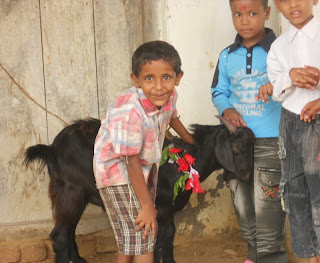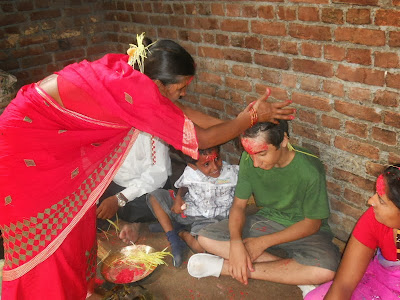In the US, you know the biggest holiday of the year is coming when you hear carols. OK, they're piped-in carols at shopping malls, but it does fill the air with festive anticipation. In Nepal, the year's biggest festival sounds like this:
Baaaaah.
Baaaaaah.
Baaaaaah.
My nephew with his dinner
Which is what I'm hearing right now, from a goat tied up somewhere in the 'hood. That means Dashain is coming and we're heading to the village soon, which is lucky, because I'll be closer to our Designated Anti-Zombie Hideout and hence have a shot at surviving the Zombie Invasion, which has already started. I'll provide the evidence shortly.
But first, Dashain. It celebrates the victory of the Goddess Durga over Evil in the form of a demon who appeared as a water buffalo -- this makes more sense if you've ever seen an irritable water buffalo -- and the male gods either couldn't do jack or were too busy talking politics or something, so they needed to call on a woman.
Enter Durga.
Durga did what women do, which is to call other women, who in this case were actually forms of herself. This probably cut down on dissension in the Demon Fighting Focus Group, although I can't get all the parts of my personality to agree with myself, so I have to hand it to Durga for her success. Hence, perhaps, her Goddess-hood. Then the nine forms of Durga, including the toughest one of all, Kali, put on a fine show of womanly collaboration and beat the crap out of Evil. The Goddess, united, can never be defeated. This makes it one of the coolest festivals on earth. In spite of the fact that Durga is often depicted as a kewpie doll in Bollywood makeup, she's a toughie. As for Kali, she's not the type for lipstick and eyeliner, and artists know better than to give her a makeover.
And now, if you're a middle-school student who stumbled onto this blog while doing a term paper, here's the ...
EDUCATIONAL SECTION!
Day One is for Parvati, Daughter of the Mountains. Her nature is great beauty, and on her day, Gatasthapana, when the new crescent moon has just barely appeared, you plant barley and keep it in the dark so the sprouts are golden and your elders can stick them behind your ear on the main festival day, because they're your elders and they can do what they want. Parvati also goes by the name of Shailapatri, and some other names too. AND of course she's part of Durga. These are the ideas South Asians came up with before they got into computers. Think of the mandala to the right as a suitably complex concept map:
 |
Mandala from ceremony to the Thousand Names of the Divine Mother.
The ceremony focuses on Lalita ("She Who Plays" or "The Spontaneous One"),
a name for Parvati and a form of Shakti/The Goddess.
|
Day Three is for Chandraghanta, The Tiger Rider. Her gift is bravery in the service of peace. Too bad she's not more famous.
Day Four is for Kushmanda, The Warm Little Cosmic Egg, who gives power to the sun and is in some sense a life-giver who created the universe. And her name really means what I said.
Day Five is for Skandamata, Mother of Kartikeya, who gave birth to a six-headed god-cum-demon fighter who was actually created by two males, Shiva and Agni. As the status update for relationships says, "It's Complicated." You could call her a surrogate mother.
Day Six is for Kathyayini, The Lion Rider, whose story is intriguing given the priority the culture has long placed on sons. She's the daughter of a great sage who prayed to the gods to give him a daughter who embodied Shakti -- not a son, but a daughter/goddess -- and he got the brave Kathyayini.
Day Seven is for Kaal Ratri, The Death of Time. This is Kali, intense and powerful and fierce. It's a day for flowers and blood. During the day, flowers and leaves are carried to the temple in a ceremonial procession. But Navaratri follows a lunar calendar, and this is a night when the half-moon rises and vanishes around midnight. It's marked in our village by a midnight she-goat slaughter. The goat is communally bought, cooked in the dark and eaten on the spot by participants. Slaughtering a she-goat is explicitly transgressive; typically only male animals are eaten. But Kaal Ratri/Kali does not follow the usual rules.
 |
| Durga shrine at Dashain near our family's home in the village |
Day Eight is for Mahagauri, The White One. Depending on who's telling it, she may be an innocent child or a nubile teenager. But she's wise. Bet on her against any demons. Incidentally, the day is called Mahasthami, a day to clean and worship your sickles, plough blades, swords and kitchen knives, perhaps because at this point the battle with demons is moving towards its apex and you'd better be ready. Also there's a really big dinner coming.
Day Nine is for Siddhidatri, Giver of Enlightenment. An enlightened person, of course, would realize that all of the goddesses are really aspects of Maha Shakti, the Great Energy, also known as Durga.
Dashain technically goes until the Full Moon, or Purnima, and Nepal's government used to shut down until then when it was a Hindu kingdom. But now they've added Eid and Christmas as public holidays, and if you've got any other holidays to be inclusive about I'm sure they'll add them too (on paper, anyway, and because otherwise the groups will call a bandh), so Dashain has lost some days. At any rate, the big celebration has always been on Day Ten, Vijaya Dashami ("Vijaya" meaning "victory"), since Durga in all her forms has finished her nine-day battle with the demons and it's time to party. That's Monday, Oct. 14 this year.
Anyway, The Big Village-Wide Party. On Dashain, that means goat. And there's no pussy-footing around in a village: If you're going to eat meat, you will not escape the death-and-blood part. Vegetarians like my father-in-law -- who is also a pandit, or priest, and appropriately observant -- sacrifice a pumpkin with full ceremony. But as tends to be the case in Hinduism (at least in my experience), your own choice is yours alone, and while he took a vow many decades ago not to touch meat or harm animals, he wouldn't insist that his choice is the only right way. For him to eat meat would be a sin, because of his vow. But the rest of the family eats meat or not, as they prefer, and for the most part they're keen on their Dashain goat.
Then it's time to EAT! (After a drippy blessing.)
The central activity of Dashain, its ceremonial raison d'etre, is to get blessed by your elders by having them plaster your forehead with yogurt, uncooked rice, and red powder. Why that's a blessing I do not know. It seems like a ritual invented by the Three Stooges when they couldn't find a cream pie. Is it marking the harvest? Is it reminding us that we're all ultimately part of the food chain?
No one I've asked could ever explain it. Oh, they could theorize, but the genesis of the smeary wet blessing is as vague and speculative as the origins of Christmas trees and Easter eggs, and no one thinks about the origins anyway when they're doing it. It's just what people have always done. It's fun. It's Dashain. And it's got that whole Hindu too-much-of-everything-is-just-enough vibe: You want a blessing from me? Well, here's a LOT of blessing! It's dripping off your forehead and onto your new Dashain clothes!

From top left: Young family members waiting for the feast and peeking in at the kalash, a ceremonial vessel to welcome goodness and fortune to the house, generally filled with water and leaves such as mango and pipal; Getting tika (blessings) from my husband's sister; Son getting a blessing from a great-aunt; Happily dripping niece.
BUT, you ask ...
WHAT DOES THIS HAVE TO DO WITH ZOMBIES?
(Other than the blood and gore part. And the part about Evil let loose in the land. And the fact that trying to do design in Blogger is turning me into one.)
Here's the thing. My son, who of course is always reliable, reports that in the last few days he has seen several men -- not one, not two, but at least three -- wandering the neighborhood, growling and grimacing and acting like they wanted to bite. I told him he was either totally exaggerating or they were drunk or crazy. Mental health care isn't exactly state-of-the-art here.
He said, "Watch out. The skeptics are always the first to get bit."
But see, luckily, we're headed within walking distance of our Designated Anti-Zombie Hideout. It's not our family's current village, which is too flat to keep away zombies. But as you surely know from World War Z, zombies cannot climb and are particularly stymied by the Himalayas. So our destination, in event of zombie breakout, is my mother-in-law's family village, which isn't far, relatively speaking. It looks like this:
 |
| 18th c. painting of Durga fighting the demon Mahisasura. You see that she is well-positioned to hit zombies in the brain, where it counts. |
We just have to get there, block off the lone dirt road (conveniently edged by sheer cliffs), and bide our time eating home-grown rice and lentils and guavas until the Zombie Apocalypse ends. Hopefully Durga will help out. They've got a lot of goats to thank her with.
So if you don't hear from me for a while, I may be celebrating Dashain in the village, or the zombies may be coming and we saw them first and have headed to the heights and I'll be able to say "I warned you."
Either that or my son is right and I'll be saying AAArrrrgggROWL CHOMP.














